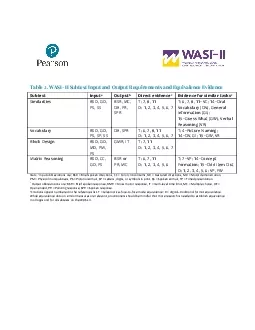

SubtestInputaOutputbDirect evidencecEvidence for similar taskscSimilaritiesBSD GD PS BSR MC OE PR SPRT 7 8 11 D 1 2 3 4 5 6 7150VC 14150Oral Vocabulary OV General Information GI 15Guess What GW Verbal ID: 868537
Download Pdf The PPT/PDF document "Table 2 WASISubtest Input and Output Req..." is the property of its rightful owner. Permission is granted to download and print the materials on this web site for personal, non-commercial use only, and to display it on your personal computer provided you do not modify the materials and that you retain all copyright notices contained in the materials. By downloading content from our website, you accept the terms of this agreement.
1 Table 2. WASISubtest Input and Output Re
Table 2. WASISubtest Input and Output Requirements and Equivalence Evidence S ubtest Input a Output b Direct evidence c Evidence for similar tasks c Similarities BSD, GD, PS, BSR, MC, OE, PR, SPR T: 7, 8, 11 D: 1, 2, 3, 4, 5, 6, 7 – VC; 14 – Oral Vocabulary (OV), General Information (GI); 15Guess What (GW), Verbal Reasoning (VR) Vocabulary BSD, GD, PS, SP, SS T: 6, 7, 8, 11 D: 1, 2, 3, 4, 5, 6, 7 T: 4 – Picture Naming; 14 – OV, GI; 15 – GW, VR Block Design GD, MD, PM, PS GMR, IT T: 7, 11 D: 1, 2, 3, 4, 5, 6, 7 Matrix Reasoning BSD, CC, GD, PS BSR or PR, MC T: 6, 7, 11 D: 1, 2, 3, 4, 5, 6 T: 7 – VP; 14 – Concept Formation; 15dd tem Out D: 1, 2, 3, 4, 5, 6: VP, FW Note le 2. WASISubtest Input and Output Requirements and Equivalence Evidence S ubtest Input a Output b Direct evidence c Evidence for similar tasks c Similarities BSD, GD, PS, BSR, MC, OE, PR, SPR T: 7, 8, 11 D: 1, 2, 3, 4, 5, 6, 7 T: 6, 7, 8, 11 – VC; 14 – Oral Vocabulary (OV), General Information (GI); 15Guess What (GW), Verbal Reasoning (VR) Vocabulary BSD, GD, PS, SP, SS OE, SPR T: 6, 7, 8, 11 D: 1, 2, 3, 4, 5, 6, 7 T: 4 – Picture Naming; 14 – OV, GI; 15 – GW, VR Block Design BSD, GD, MD, PM, PS GMR, IT T: 7, 11 D: 1, 2, 3, 4, 5, 6, 7 Matrix Reasoning BSD, CC, GD, PS BSR or PR, MC T: 6, 7, 11 D: 1, 2, 3, 4, 5, 6 T: 7 – VP; 14 – Concept Formation; 15–Odd tem Out D: 1, 2, 3, 4, 5, 6: VP, FW NoteInput abbreviations are: BSD = Brief spoken directions, CC = Color critical items, GD = Gestured directions, MD = Motor demonstration, PM = Physical manipulatives, PS = Pictorial stimuli, SP = Letters, digits, or symbols in print, SS = Spoken stimuli, TP = Timed presentationb Output abbreviations are: BSR = Brief spoken response, GMR = Gross motor response, IT = Itemlevel time limit, MC = Multiple choice, OE = Open ended, PR = Pointing response, SPR = Spoken response. Citations appear numbered in the references list. T = telepractice–faceface mode equivalence; D = digitaltraditional format equivalence.While equivalence data on similar measures are relevant, practitioners should be mindful that more research is needed to establish equivalence in all ages and for all subtestson the WASI–II.